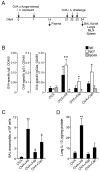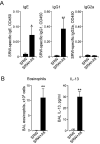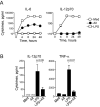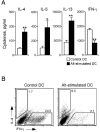Asthma-related environmental fungus, Alternaria, activates dendritic cells and produces potent Th2 adjuvant activity
- PMID: 19201906
- PMCID: PMC2653279
- DOI: 10.4049/jimmunol.0802773
Asthma-related environmental fungus, Alternaria, activates dendritic cells and produces potent Th2 adjuvant activity
Abstract
Asthma is thought to result from dysregulated Th2-like airway inflammatory responses to the environment. Although the etiology of asthma is not fully understood in humans, clinical and epidemiological evidence suggest a potential link between exposure to environmental fungi, such as Alternaria, and development and/or exacerbation of asthma. The goal of this project was to investigate the mechanisms of airway Th2 responses by using Alternaria as a clinically relevant model for environmental exposure. Airway exposure of naive animals to an experimental Ag, OVA, or a common allergen, short ragweed pollen, induced no or minimal immune responses to these Ags. In contrast, mice developed strong Th2-like immune responses when they were exposed to these Ags in the presence of Alternaria extract. Extracts of other fungi, such as Aspergillus and Candida, showed similar Th2 adjuvant effects, albeit not as potently. Alternaria stimulated bone marrow-derived dendritic cells (DCs) to express MHC class II and costimulatory molecules, including OX40 ligand, in vitro. Importantly, Alternaria inhibited IL-12 production by activated DCs, and DCs exposed to Alternaria enhanced Th2 polarization of CD4(+) T cells. Furthermore, adoptive airway transfer of DCs, which had been pulsed with OVA in the presence of Alternaria, showed that the recipient mice had enhanced IgE Ab production and Th2-like airway responses to OVA. Thus, the asthma-related environmental fungus Alternaria produces potent Th2-like adjuvant effects in the airways. Such immunogenic properties of certain environmental fungi may explain their strong relationships with human asthma and allergic diseases.
Figures








References
-
- Umetsu DT, McIntire JJ, Akbari O, Macaubas C, DeKruyff RH. Asthma: an epidemic of dysregulated immunity. Nat. Immunol. 2002;3:715–720. - PubMed
-
- Holt PG, Macaubas C, Stumbles PA, Sly PD. The role of allergy in the development of asthma. Nature. 1999;402:B12–17. - PubMed
-
- Cohn L, Elias JA, Chupp GL. Asthma: mechanisms of disease persistence and progression. Annu. Rev. Immunol. 2004;22:789–815. - PubMed
-
- Akbari O, DeKruyff RH, Umetsu DT. Pulmonary dendritic cells producing IL-10 mediate tolerance induced by respiratory exposure to antigen. Nat. Immunol. 2001;2:725–731. - PubMed
Publication types
MeSH terms
Substances
Grants and funding
LinkOut - more resources
Full Text Sources
Medical
Research Materials

